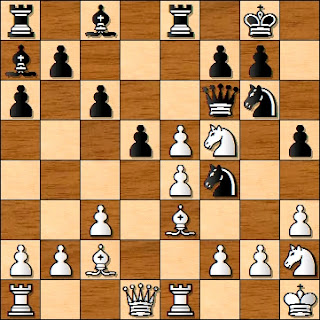Nell’estate del 1857 Serafino Dubois si confrontò in un match “alternato” – all’italiana e con le regole internazionali – con il conte – nonché presidente del Circolo Scacchistico di Lipsia – Conrad Woldemar von Ekstädt Vitzthum (1802-1875) e si impose nella proporzione di 4 a 1. Nel nostro libretto
“Serafino Dubois il Professionista”, Messaggerie Scacchistiche, Brescia, 2000, pp. 40-45, presentammo cinque partite del match (un Gambetto di Donna, una Francese e tre Gambetti di Re). Georges Bertola ne produsse poi una sesta (un Gambetto Scozzese: cfr. Georges Bertola, “Serafino Dubois e l’arrocco all’italiana”,
Torre & Cavallo Scacco!, n. 11, novembre 2004, pp. 25-28). Eccone allora anche una settima, riposta e dimenticata nelle
back pages della rivista olandese
Sissa, 1859, pp. 342-343:
S. Dubois – C. W. von E. Vitzthum
Roma, 1857
Francese C01
1. e4 e6 2. d4 d5 3. exd5 exd5 4. Ad3 Ae6 5. Cf3 Ad6 6. Cc3 In un’altra partita Serafino preferì, sulla scia di Paul Morphy, 6. 0-0 h6 7. Ae3 Cf6 8. Cc3 c6 9. Ce5 (Dubois – Vitzthum, Roma, I giugno 1857); cfr. Alessandra Innocenti & Lorenzo Barsi, op. cit., pp. 41-42. 6. ... Cf6 7. 0-0 Cbd7 8. Te1 0-0 L’anonimo commentatore di Sissa (Jean Dufresne?) accenna a 8. ... h6, ma allora 9. Af5 è per il Nero una pillola amara. 9. Ag5 c6 10. Ce5 Dc7 11. Cxd7 Cxd7 12. Dh5 g6 13. Dh6 Tfe8 14. Te3 f5 Se 14. ... Af8 (Δ Af8-g7) allora 15. Dh4. La risposta del testo è più compromettente. 15. Tae1 Cf8 16. f4 a6 Prepara c6-c5. 17. h4? Dubois apre il fuoco... Quasi chiunque oggigiorno preferirebbe la più posizionale 17. Ca4. 17. ... Df7 Vale lo stesso per il Nero: perché non 17. ... Dg7!, onde neutralizzare radicalmente l’attacco avversario? 18. h5 Tac8 19. hxg6 Cxg6 20. g4! fxg4? Un esempio di collaborazionismo autolesionista. L’imperativo era 20. ... Ad7! ove se 21. Cd1 allora 21. ... Tf8 con approssimativo equilibrio. 21. f5! Axf5 22. Txe8+ Txe8 23. Tf1 Dg7? Più resiliente 23. ... Af8!, benché dopo 24. Dh2! (24. Dh5 Dc7!) 24. ... Ag7 25. Txf5 Axd4+ 26. Rg2 il Bianco serbi prospettive gratificanti. 24. Axf5 I Maestri dell’epoca disdegnavano spesso la tecnica (24. Dxg7+), anche contro la propria convenienza! 24. ... Dxd4+ 25. Rh1 Af8 26. Dh5 Dg7? Dopo la stupefacente 26. ... Te1!! 27. Txe1 Df2 il Nero arranca, ma combatte ancora. 27. Dxg4 Ae7 28. Ae6+ Rh8 29. Tf7 De5
 30. Txh7+!
30. Txh7+! Il sigillo romantico!
30. ... Rxh7 31. Dh5+ Rg7 32. Dh6 matto 1 : 0.





























